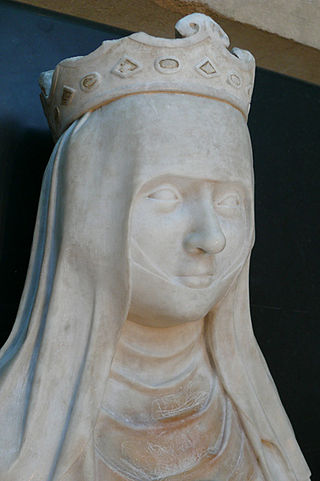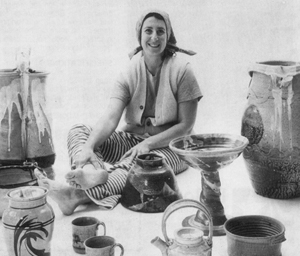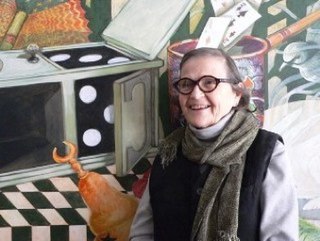
Janetta Rebold Benton is an American art historian. She is currently Distinguished Professor of Art History at Pace University in New York.

Janetta Rebold Benton is an American art historian. She is currently Distinguished Professor of Art History at Pace University in New York.
Benton received a Bachelor of Fine Arts from Cornell University in 1967 and a Master of Arts degree from George Washington University in 1969. She received a PhD from Brown University in 1980. She also earned an MDP diploma from the Management Development Program at the Harvard University Graduate School of Education. [1]
Her main focus of study is the art of the medieval and Renaissance periods. She has a particular interest in iconography, including images of animals, especially fantastic fauna and gargoyles. [1]
In 2018 Benton received a second Fulbright award to teach at the Graduate School of Art History of the China Academy of Art, Hangzhou.
In 2012 she received a Fulbright Senior Scholar Award to teach at the Graduate School of Art History, European University, St. Petersburg, Russia.
She taught art history courses at the American Embassy in Paris, 1981-85.
Benton has presented subscription lecture series for the Smithsonian Associates in Washington, DC, 1988-today, and at the Metropolitan Museum of Art in New York every season 1988-2011. She serves as the Expert on trips abroad for Smithsonian Journeys and the Metropolitan Museum of Art.
In 1995 she was the guest curator and catalog author for an exhibition on "Medieval Monsters: Dragons and Fantastic Creatures" at the Katonah Museum of Art.

A bestiary is a compendium of beasts. Originating in the ancient world, bestiaries were made popular in the Middle Ages in illustrated volumes that described various animals and even rocks. The natural history and illustration of each beast was usually accompanied by a moral lesson. This reflected the belief that the world itself was the Word of God and that every living thing had its own special meaning. For example, the pelican, which was believed to tear open its breast to bring its young to life with its own blood, was a living representation of Jesus. Thus the bestiary is also a reference to the symbolic language of animals in Western Christian art and literature.

In architecture, and specifically Gothic architecture, a gargoyle is a carved or formed grotesque with a spout designed to convey water from a roof and away from the side of a building, thereby preventing it from running down masonry walls and eroding the mortar between. Architects often used multiple gargoyles on a building to divide the flow of rainwater off the roof to minimize potential damage from rainstorms. A trough is cut in the back of the gargoyle and rainwater typically exits through the open mouth. Gargoyles are usually elongated fantastical animals because their length determines how far water is directed from the wall. When Gothic flying buttresses were used, aqueducts were sometimes cut into the buttress to divert water over the aisle walls.

Since at least the 18th century, grotesque has come to be used as a general adjective for the strange, mysterious, magnificent, fantastic, hideous, ugly, incongruous, unpleasant, or disgusting, and thus is often used to describe weird shapes and distorted forms such as Halloween masks. In art, performance, and literature, however, grotesque may also refer to something that simultaneously invokes in an audience a feeling of uncomfortable bizarreness as well as sympathetic pity.

Joan of Évreux was Queen of France and Navarre as the third wife of King Charles IV of France.
Lowery Stokes Sims is an American art historian and curator of modern and contemporary art known for her expertise in the work of African, African American, Latinx, Native and Asian American artists such as Wifredo Lam, Fritz Scholder, Romare Bearden, Joyce J. Scott and others. She served on the curatorial staff of the Metropolitan Museum of Art, the Studio Museum in Harlem, and the Museum of Arts and Design. She has frequently served as a guest curator, lectured internationally and published extensively, and has received many public appointments. Sims was featured in the 2010 documentary film !Women Art Revolution.

Elizabeth Woodman was an American ceramic artist.

Portrait of Princess is a tempera painting on panel attributed to the Italian Late-Gothic master Pisanello. It was probably executed between 1435 and 1445 and is also known as Portrait of a Princess of the House of Este. It is firmly attributed to Pisanello on stylistic grounds and because he stayed in Ferrara in the period, where he also finished a portrait and a celebrative medal of Marquis Leonello d'Este.

In architecture, a grotesque or chimera is a fantastic or mythical figure used for decorative purposes. Chimerae are often described as gargoyles, although the term gargoyle technically refers to figures carved specifically as terminations to spouts which convey water away from the sides of buildings. In the Middle Ages, the term babewyn was used to refer to both gargoyles and chimerae. This word is derived from the Italian word babuino, which means "baboon".
Arline Fisch is an American artist and educator. She is known for her work as a metalsmith and jeweler, pioneering the use of textile processes from crochet, knitting, plaiting, and weaving in her work in metal. She developed groundbreaking techniques for incorporating metal wire and other materials into her jewelry.
Robert Ebendorf is an American metalsmith and jeweler, known for craft, art and studio jewelry, often using found objects. In 2003–2004, the Smithsonian American Art Museum organized an exhibition of 95 pieces, titled The Jewelry of Robert Ebendorf: A Retrospective of Forty Years.

A legendary creature is a type of fictional entity, typically a hybrid, that has not been proven and that is described in folklore, but may be featured in historical accounts before modernity.

Tom Shannon, is an American artist and inventor.

Portrait of Margaret van Eyck is a 1439 oil on wood painting by the Early Netherlandish master Jan van Eyck. It is one of the two latest of his surviving paintings, and one of the earliest European artworks to depict a painter's spouse. Completed when she was around 34, it was hung until the early 18th century in the Bruges chapel of the Guild of painters. The work is thought to be a pendant or diptych panel for either a now lost self-portrait known from records until 1769, or of Jan van Eyck's likely self-portrait now in the National Gallery in London.

The Apocalypse Tapestry is a large medieval set of tapestries commissioned by Louis I, the Duke of Anjou, and woven in Paris between 1377 and 1382. It depicts the story of the Apocalypse from the Book of Revelation by Saint John the Divine in colourful images, spread over six tapestries that originally totalled 90 scenes, and were about six metres high, and 140 metres long in total.

Ellen Lanyon was a painter and printmaker from Chicago, Illinois. She received her BFA from the School of the Art Institute of Chicago (SAIC), her MFA from the University of Iowa School of Art and Art History and studied restoration at the Courtauld Institute of Art. She also received an honorary doctorate from SAIC. Her works are in the permanent collections of many major American museums, including the Art Institute of Chicago, the Museum of Contemporary Art Chicago, the Metropolitan Museum of Art, the Smithsonian American Art Museum, and the Ulrich Museum.
Jane Dickson is an American painter. She lives and works in New York City..
Annu Palakunnathu Matthew is a British photographer. Her work has been exhibited at the Rhode Island School of Design Museum; Guangzhou Biennial of Photography, China; Tang Museum, New York; and The Smithsonian National Museum of Natural History. Matthew is a professor of art (photography) in the University of Rhode Island's Department of Art and Art History.
Nancy Goldring is an American artist. Her art practice combines graphic, photographic, and projected material, presented as a non-narrative series of images that she calls "foto-projections." Goldring currently lives and works in New York City, and is a professor emerita, Montclair State University.

The gargoyle is a fantasy and horror monster inspired by the gargoyle architectural element. While they were believed in mythology to frighten away evil spirits, the idea of such statues physically coming to life is a more recent notion. Like golems, they are usually made of magically animated or transformed stone, but have animal or chimera traits and are often guardians of a place such as a cathedral or castle. They can also be depicted as vessels for demonic possession or as a living species resembling statues.
James Snyder (1928–1990) was an American art historian, specializing in northern Renaissance art. His Northern Renaissance Art of 1985 was a standard textbook on the subject for several decades, with a posthumous revised edition in 2005, revised by Larry Silver and Henry Luttikhuizen, being somewhat replaced by Jeffrey Chipps Smith's The Northern Renaissance of 2004. Snyder taught at Bryn Mawr College from 1964 until his retirement in 1989. He died of liver disease in August 1990, aged 62.